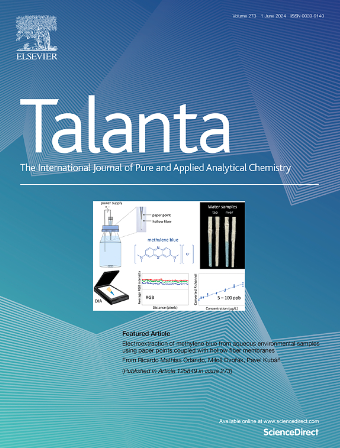用于增强表面抗原成像的单个组织切片的受限电化学发光
IF 5.6
1区 化学
Q1 CHEMISTRY, ANALYTICAL
引用次数: 0
摘要
组织表面分子的空间分析需要高灵敏度、高分辨率的成像方法。在这里,我们提出了一个有限的电化学发光(ECL)在单个组织切片,以增强表面抗原的成像。通过在电极处放置与组织切片接触的玻片,在组织处形成一个密闭空间,以丰富ECL自由基并增强ECL发射。同时,催化自由基的有限扩散使ECL发射在电极表面附近定位,消除了轴向离焦模糊,保证了精确的分子定位。因此,这种建立的成像方法具有增强的ECL发射和高空间分辨率,可用于在单个组织切片上绘制癌胚抗原(CEA),并在单个肺腺癌组织上区分癌区和癌旁区。除了CEA抗原在这两个区域的含量不同外,在结构致密的癌区,观察到TPrA自由基的集中,导致ECL释放进一步增强。在组织切片上清晰识别癌区,灵敏度高,显示了该ECL成像方法在体外诊断和早期癌症诊断中的潜在应用。本文章由计算机程序翻译,如有差异,请以英文原文为准。

Confined electrochemiluminescence at single tissue sections for enhanced imaging of surface antigens
Spatial analysis of tissue surface molecules demands the imaging methods with high sensitivity and resolution. Here, we present a confined electrochemiluminescence (ECL) at single tissue sections for enhanced imaging of surface antigens. By placing a glass slide in contact with the tissue section at the electrode, a confined space is formed at the tissue to enrich the ECL radicals and boost the ECL emission. Meanwhile, the restricted diffusion of coreactant radicals localizes the ECL emission near the electrode surface, eliminating axial defocus blur and ensuring precise molecular localization. Consequently, this established imaging method with enhanced ECL emission and high spatial resolution is applied to map carcinoembryonic antigen (CEA) at single tissue sections and differentiate cancerous and paracancerous regions at single lung adenocarcinoma tissues. Besides the difference in the amounts of CEA antigen at these two regions, the cancerous regions with a dense structure are observed to have concentrated TPrA radicals resulting in a further enhancement in ECL emission. The clear recognition of cancerous region at the tissue section with a high sensitivity exhibits the potential application of this ECL imaging method for in vitro diagnostics and early cancer diagnosis.
求助全文
通过发布文献求助,成功后即可免费获取论文全文。
去求助
来源期刊

Talanta
化学-分析化学
CiteScore
12.30
自引率
4.90%
发文量
861
审稿时长
29 days
期刊介绍:
Talanta provides a forum for the publication of original research papers, short communications, and critical reviews in all branches of pure and applied analytical chemistry. Papers are evaluated based on established guidelines, including the fundamental nature of the study, scientific novelty, substantial improvement or advantage over existing technology or methods, and demonstrated analytical applicability. Original research papers on fundamental studies, and on novel sensor and instrumentation developments, are encouraged. Novel or improved applications in areas such as clinical and biological chemistry, environmental analysis, geochemistry, materials science and engineering, and analytical platforms for omics development are welcome.
Analytical performance of methods should be determined, including interference and matrix effects, and methods should be validated by comparison with a standard method, or analysis of a certified reference material. Simple spiking recoveries may not be sufficient. The developed method should especially comprise information on selectivity, sensitivity, detection limits, accuracy, and reliability. However, applying official validation or robustness studies to a routine method or technique does not necessarily constitute novelty. Proper statistical treatment of the data should be provided. Relevant literature should be cited, including related publications by the authors, and authors should discuss how their proposed methodology compares with previously reported methods.
 求助内容:
求助内容: 应助结果提醒方式:
应助结果提醒方式:


